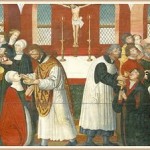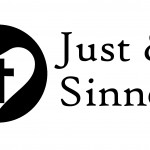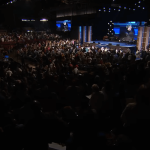Since the last post on baptism had such a good reception, I’ve decided to continue posting my Bible study outlines. Again, feel free to use it in your own congregation or for any other purpose.
Why Do Lutherans Believe in the Real Presence of Christ’s Body and Blood in the Lord’s Supper?
- There are a variety of different perspectives on exactly what happens during the Sacrament of the Lord’s Supper
- The memorialist view: This perspective, held by many evangelicals, is that the Lord’s Supper is simply an act by which we remember the cross.
- The Roman Catholic view: The elements of bread and wine are transubstantiated, or turned into, the literal body and blood of Christ. The bread and wine no longer exist.
- The Calvinist view: Christ’s body and blood are not actually present in the Lord’s Supper, but the Christian, through faith, spiritually ascends to heaven and fellowships with Christ.
- The Lutheran view: In Holy Communion, Christ’s body and blood are truly present under the forms of bread and wine, and are received by all who partake of the Supper.
- The direction of the Supper: Is it something that we offer to God, or something that God offers to us?
- In the memorialist view, Communion is about what we do to remember Christ.
- In the Roman view, the Supper is a re-presentation of Christ’s sacrifice as an act of propitiation performed by the priest.
- In the Reformed view, the Supper is about the ascent of our souls up to God.
- In the Lutheran view, the Supper is an act of pure grace. God is coming down to us as a gift.
- The words of institution (Matt. 28:26-29; Mark 14:22-25; Luke 22:19-20; 1 Cor. 11:24-26)
- The controversy about the Lord’s Supper often surrounds the interpretation of the words: “This is my body.”
- Some people interpret this phrase in a symbolic way, arguing that “this is my body” means “this represents my body.”
- If Jesus meant “this represents my body,” why didn’t he just say “this represents my body?” There are plenty of ways to do so in Greek. All of the Gospel writers record the word “is,” instead of “represents.”
- Jesus’ words should be taken at face value unless there is some significant reason to interpret them in another way.
- Paul writes that the Lord’s Supper is an actual participation in Christ’s body and blood (1 Cor. 10:16).
- If Paul believed the Supper simply to be a “representation,” he would not have used this language.
- Some argue that “body of Christ” refers to the church. However, Paul also speaks about participating in the “blood of Christ,” which is never used to refer to anything in Scripture other than the actual blood of Christ.
- This is further defended by the fact that Paul says that those who take unworthily sin against the body and blood of Christ (1 Cor. 11:27).
i. If it’s simply a symbol, why would it be a sin against Christ’s actual body and blood?
- The Lord’s Supper is the fulfillment of the Passover
- At the Passover, a lamb was killed, and its blood place over one’s doorpost so that one might be spared from death.
- This event was commemorated every year by the Jewish people, not by partaking in a representation of a lamb, but by eating an actual lamb.
- In Scripture, the fulfillment of an Old Testament type is always greater than the type. The pictures in the Old Testament portray the reality to be fulfilled in the New.
- If the Lord’s Supper is greater than the Passover, it must then be something more than just a symbol. If it is only symbolic, then it serves exactly the same function, because Passover is also a picture of the death of Christ.
- In fact, wouldn’t the slaughtering of a lamb in a sense be a better picture of Jesus’ death than simply eating some bread and drinking some wine?
- It is much more likely that just as the Israelites partook of an actual lamb on Passover, we partake of the true Lamb of God through the Lord’s Supper.
- Objections:
- The phrase “this is my body” is symbolic just like when Jesus says “I am the vine.”
i. Answer: These are not parallel statements, or parallel figures of speech.
ii. Which word is symbolic in the second phrase? Is it “am” or “vine?”
iii. In the words of institution, what is symbolic? “Is” or “body?”
iv. In the phrase “I am the vine,” it is the direct object “vine,” which is symbolic. Jesus literally is the vine. One simply has to interpret “vine,” in a non-literal sense.
v. For this parallel to work, it would have to be the word “body” which is symbolic, not the word “is.” However, memorialists don’t make this argument.
- If “is” means “is,” doesn’t that sound more like the Roman Catholic view, that the bread and wine no longer exist?
i. Answer: No. Just because it is Christ’s body doesn’t mean that it is not also bread. Just because we confess that Jesus is God, that does not mean that we don’t also confess that he is man. We receive both things at once. We know this because Paul speaks about partaking of bread and wine (1 Cor. 10:16-17).
- How can Christ’s body be present in the Supper if he is at the right hand of God the Father?
i. Answer: “The right hand of God the Father,” is not a literal place. God doesn’t have hands, and does not have a body which is restricted to an actual throne which Jesus sits next to. Instead, this phrase refers to Christ’s place of authority over all of creation.
ii. Jesus is present everywhere according to both natures (Eph. 4:10).
- Conclusion: The Lord’s Supper involves an actual reception of Christ’s true body and blood under the forms of bread and wine.
Here is a pdf of the outline:












